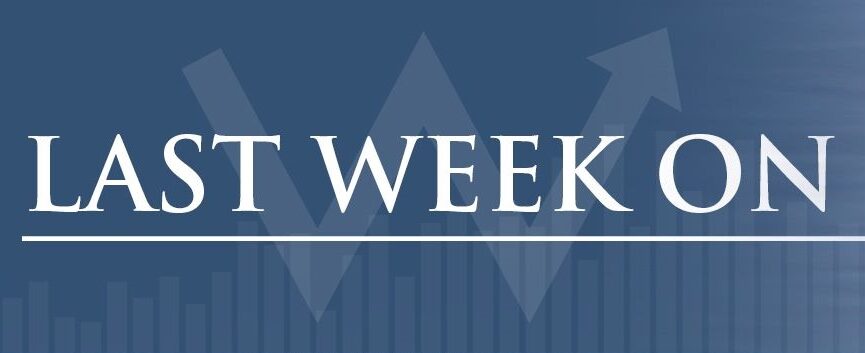S&P 500: -4.25% DOW: -2.93% NASDAQ:-5.77% 10-YR Yield: 3.71%
What Happened?
A restful Labor Day holiday did little to calm markets as the shortened week saw major equity indexes decline significantly. Growth concerns, fueled by recent economic data, drove the sell-off. A weak manufacturing report indicating continued contraction combined with Friday’s disappointing jobs report to give investors reason to sell. All eyes are now on the Federal Reserve as it assesses incoming data to determine how aggressively it will ease policy and whether those measures can alleviate economic pressure enough to avoid a slowdown.
Technically, the aggressive run-up in equities this year has fostered a downside bias, with market participants leaning into the consolidation. The S&P 500’s failure to break through a key resistance level has opened the door for more selling pressure.
For the first time in years, bonds have reasserted their traditional role as a diversifier, helping cushion the impact of poor equity performance. The 2-year and 10-year Treasury yields dropped by 0.28% and 0.20%, respectively, driving bond prices higher and offsetting some of the losses in the equity markets.

August Payrolls Grew By a Less-Than-Expected 142,000, But Unemployment Rate Ticked Down to 4.2%
- Nonfarm payrolls expanded by 142,000 during August, up from 89,000 in July and below the 161,000 expectation.
- The unemployment rate ticked down to 4.2%, as expected.
- The previous two months saw substantial downward revisions. The BLS cut July’s total by 25,000, while June fell to 118,000, a downward revision of 61,000.
The key takeaway – Recent labor market data suggests the economy may be approaching a turning point toward a larger slowdown. We have not only seen weaker job reports but also downward revisions to previous data, reinforcing expectations for a rate cut by the Fed in September. However, the bigger question is whether the Fed might cut more than the expected 0.25%.
After the release, Fed Governor Christopher Waller advocated “front-loading rate cuts if that is appropriate,” highlighting the potential need for proactive measures to mitigate potential tail risks. The Fed faces a choice: start with steady 0.25% cuts in September and signal a readiness to do more if economic data continues to weaken, or opt for a more aggressive 0.5% cut, which could unsettle markets by signaling deeper economic concerns. Markets are still pricing in one 0.25% cut at the meeting this month and pricing in a full percentage point reduction by 2025.

Economy Grew Again in August, ISM Finds, But Momentum Faded
- The ISM Services Index rose a hair to 51.5% last month from 51.4% in July
- New orders, production, and prices-paid rose slightly while employment fell
- The ISM Manufacturing Index edged up to 47.2% from an eight-month low of 46.8%
- Production and new orders fell sharply while employment and prices-paid rose
The key takeaway – The ISM data released this week adds another layer to the evidence that the US economy may be experiencing stagnation, sparking concerns that this is less a stabilization and more of a slowdown. The services sector continues to show tepid growth, while manufacturing remains in contractionary territory. Taking the optimistic view, manufacturing’s struggles over the past couple of years have had minimal impact on overall economic growth due to its smaller share of the economy. Meanwhile, the services sector, while slowing, has yet to enter contraction, and new orders—a key indicator of future demand—remain stable.
Additionally, the Federal Reserve is expected to begin its rate-cutting cycle, which could help relieve some of the current economic pressures.

Fed’s Beige Book Shows Stagnant, Declining US Economic Activity
- Economic activity was flat or declining across most regions in the US in recent weeks, the Federal Reserve said in its Beige Book survey
- Employment levels were generally flat to up slightly, while reported layoffs were rare
- Prices and wages increased modestly during the period
- Contacts, however, generally expected economic activity to remain stable or improve somewhat in coming months
The key takeaway – The Federal Reserve’s Beige Book survey assists FOMC members in their assessment of the economy and in shaping interest rate policy. Ahead of the September meeting, the survey from district members flashed mixed signals. A slowdown in hiring paired with lower layoffs suggests a stable job market, consistent with other recent data.
The reported decline in business activity is likely to catch the Fed’s attention as it prepares for the FOMC meeting. Economic data from the past month or two has prompted investors to reconsider the potential for growth instability. While the FOMC may welcome less focus on inflation, the shift toward concerns about growth presents its own set of challenges, making for a still difficult balancing act.

From Around the Watercooler
Tesla announced it wants to launch its Full Self-Driving (FSD) product in Europe and Asia early next year, pending regulatory approval
Alex Morgan, the GOAT of women’s soccer, announced she’ll retire at the end of the NWSL season
Ford sales increased 13.4% last month, bolstered by strong demand for SUVs and pickup trucks
Verizon is said to be in talks to buy Frontier Communications to bolster its fiber-optic cable network


